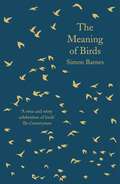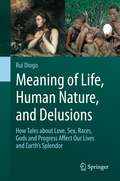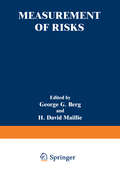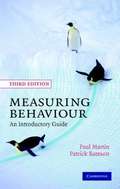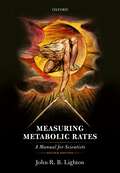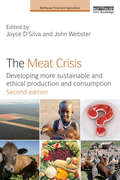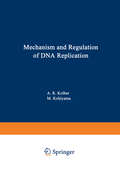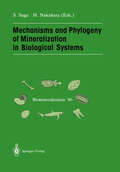- Table View
- List View
Mean and Lowly Things: Snakes, Science, and Survival in the Congo
by Kate JacksonIn 2005 Kate Jackson ventured into the remote swamp forests of the northern Congo to collect reptiles and amphibians. Her camping equipment was rudimentary, her knowledge of Congolese customs even more so. She knew how to string a net and set a pitfall trap, but she never imagined the physical and cultural difficulties that awaited her. Culled from the mud-spattered pages of her journals, Mean and Lowly Things reads like a fast-paced adventure story. It is Jackson’s unvarnished account of her research on the front lines of the global biodiversity crisis—coping with interminable delays in obtaining permits, learning to outrun advancing army ants, subsisting on a diet of Spam and manioc, and ultimately falling in love with the strangely beautiful flooded forest. The reptile fauna of the Republic of Congo was all but undescribed, and Jackson’s mission was to carry out the most basic study of the amphibians and reptiles of the swamp forest: to create a simple list of the species that exist there—a crucial first step toward efforts to protect them. When the snakes evaded her carefully set traps, Jackson enlisted people from the villages to bring her specimens. She trained her guide to tag frogs and skinks and to fix them in formalin. As her expensive camera rusted and her Western soap melted, Jackson learned what it took to swim with the snakes—and that there’s a right way and a wrong way to get a baby cobra out of a bottle.
The Meaning of Birds
by Simon BarnesOne of our most eloquent nature writers offers a passionate and informative celebration of birds and their ability to help us understand the world we live in. As well as exploring how birds achieve the miracle of flight; why birds sing; what they tell us about the seasons of the year and what their presence tells us about the places they inhabit, The Wisdom of Birds muses on the uses of feathers, the drama of raptors, the slaughter of pheasants, the infidelities of geese, and the strangeness of feeling sentimental about blue tits while enjoying a chicken sandwich. From the mocking-birds of the Galapagos who guided Charles Darwin toward his evolutionary theory, to the changing patterns of migration that alert us to the reality of contemporary climate change, Simon Barnes explores both the intrinsic wonder of what it is to be a bird – and the myriad ways in which birds can help us understand the meaning of life.
Meaning of Life, Human Nature, and Delusions: How Tales about Love, Sex, Races, Gods and Progress Affect Our Lives and Earth's Splendor
by Rui DiogoWhatever are your beliefs, background, education, political views or interests, one thing is sure: this book will engage you, teach you something new, and more importantly make you to re-think deeply about critical aspects of your daily-life, including sex, love, food, physical activities, diseases, work and stress, and how you see and deal with other people, other animals, and the planet in general. Indeed, it focuses on topics that have fascinated people from all places and historical periods since times immemorial: Why are we here? What is the meaning of life? Are we progressing, and will we thrive? It does this by integrating in a unique fashion information from ancient Greek, Sumerian, Hindu, Jewish, Buddhist, Christian and Muslim texts to high-tech brain research, facts about near-death experiences, Covid-19, QAnon conspiracies, virtual reality and dating aps; from Adam and Eve to the rise of misogyny and racism to Black Lives Matter, Me-Too, Hollywood romantic movies and Disney fairy-tales. Contrary to notions about 'human progress' and 'Homo Deus' defended by authors such as Harari, Pinker and Dawkins, it shows that human history instead involves the repetition of similar imaginary tales created by a combination of traits found in other animals and the uniquely human obsession about 'cosmic purpose' stories related to our awareness of death's inevitability. Organized religions appeared later, chiefly during the rise of agriculture and 'civilizations'. Diogo navigates mesmerizing untold stories revealing a paradox: these events and the industrial 'revolution' increased inequality, oppression, slavery, subjugation of women, famines, plagues, 'work', stress, and suicides. Data from psychology, biology, neurobiology, and cross-cultural studies of hunter-gatherers and so-called 'developed' societies reveal an even more profound paradox: within all forms of life, the 'sapient being' is the one immersed in Neverland's world of unreality - truly a Homo irrationalis, fictus and socialis believing in fictional tales about cosmic 'duties', 'romantic meant to be', demons, inferior 'races' and 'genders', conspiracies, and 'justified' slavery, warfare, genocides, and animal abuses. Importantly, such tales play, on the other hand, crucial functions such as help coping with death and a plethora of societal troubles, decreasing stress, or preventing drug and alcohol abuse. An optimist and passionate wondered and wanderer, Diogo provides enthralling details about the history of religion, discrimination, romantic love, warfare, diseases and Earth's biodiversity illustrating how 'virtue is in the middle' and that we - with our intriguing combination of beliefs, bodily needs and desires, artistic abilities, and mismatches between our senses' illusions and the cosmos' reality - are not 'better' or 'worse' than the other millions of captivating living species. This powerful and urgently needed message has critical repercussions for how we understand, care about, and mindfully enjoy living in this splendid planet, in the reality of here and now.Pre-publication comments: "I applaud the enormous work that Diogo has invested in this follow-up to his widely acclaimed Evolution driven by organismal behavior book, and the challenge of getting people to think beyond and outside of our usual set of definitions and expectations. The case-studies provided in the book are fascinating and insightful" (Drew Noden, Award-winning Emeritus Professor, Cornell University)"Rui Diogo is becoming the Slavoj Zizek of evolutionary biology" (Marcelo Sanchez-Villagra, Director of the Paleontological Institute and Museum of the University of Zurich)
Measurement of Ion Transport and Metabolic Rate in Insects (Springer Series in Experimental Entomology)
by T. J. Bradley T. A. MillerInsects as a group occupy a middle ground in the biosphere between bacteria and viruses at one extreme, amphibians and mammals at the other. The size and general nature of insects present special problems to the student of entomology. For example, many commercially available instruments are geared to measure in grams, while the forces commonly encountered in stUdying insects are in the milligram range. Therefore, techniques developed in the study of insects or in those fields concerned with the control of insect pests are often unique. Methods for measuring things are common to all sciences. Advances sometimes depend more on how something was done than on what was measured; indeed a given field often progresses from one technique to another as new methods are discovered, developed, and modified. Just as often, some of these techniques find their way into the classroom when the problems involved have been sufficiently ironed out to permit students to master the manipulations in a few laboratory periods. Many specialized techniques are confined to one specific research laboratory. Although methods may be considered commonplace where they are used, in another context even the simplest procedures may save considerable time. It is the purpose of this series (1) to report new developments in methodology, (2) to reveal sources of groups who have dealt with and solved particular entomological problems, and (3) to describe experiments which may be applicable for use in biology laboratory courses.
Measuring Arthropod Biodiversity: A Handbook of Sampling Methods
by Jean Carlos Santos Geraldo Wilson FernandesThis book brings together a wide range of sampling methods for investigating different arthropod groups. Each chapter is organised to describe and evaluate the main sampling methods (field methods, materials and supplies, sampling protocols, effort needed, and limitations); in addition, some chapters describe the specimen preparation and conservation, species identification, data collection and management (treatment, statistical analysis, interpretation), and ecological/conservation implications of arthropod communities. The book aims to be a reference for zoologists, entomologists, arachnologists, ecologists, students, researchers, and for those interested in arthropod science and biodiversity. We hope the book will contribute to advance knowledge on field assessments and conservation strategies. Arthropods represent the most speciose group of organisms on Earth, with a remarkable number of species and interactions still to be described. These invertebrates are recognized for playing key ecological roles in terrestrial, freshwater and marine ecosystems. Because of the increasing and relentless threats arthropods are facing lately due to a multitude of human induced drivers, this book represents an important contribution to assess their biodiversity and role in ecosystem functioning and generation of ecosystem services worldwide.
Measuring Behaviour: An Introductory Guide
by Paul MartínMeasuring Behaviour has established itself as a standard text. Largely rewritten, updated and reorganised, this third edition is, as before, a guide to the principles and methods of quantitative studies of behaviour, with an emphasis on techniques of observation, recording and analysis. It provides the basic knowledge needed to measure behaviour, doing so in a succinct and easily understood form. The sections on research design and the interpretation and presentation of data have been greatly expanded. Written with brevity and clarity, Measuring Behaviour is, above all, a practical guide book. Aimed primarily at undergraduate and graduate students in biology and psychology who are about to embark upon quantitative studies of animal and human behaviour, this book provides a concise review of methodology that will be of great value to scientists of all disciplines in which behaviour is measured, including biological anthropology, the social sciences and medicine.
Measuring Biological Diversity
by Anne E. MagurranThis accessible and timely book provides a comprehensive overview of how to measure biodiversity. The book highlights new developments, including innovative approaches to measuring taxonomic distinctness and estimating species richness, and evaluates these alongside traditional methods such as species abundance distributions, and diversity and evenness statistics. Helps the reader quantify and interpret patterns of ecological diversity, focusing on the measurement and estimation of species richness and abundance. Explores the concept of ecological diversity, bringing new perspectives to a field beset by contradictory views and advice. Discussion spans issues such as the meaning of community in the context of ecological diversity, scales of diversity and distribution of diversity among taxa Highlights advances in measurement paying particular attention to new techniques such as species richness estimation, application of measures of diversity to conservation and environmental management and addressing sampling issues Includes worked examples of key methods in helping people to understand the techniques and use available computer packages more effectively
Measuring Biological Diversity
by Anne E. MagurranThis accessible and timely book provides a comprehensive overview of how to measure biodiversity. The book highlights new developments, including innovative approaches to measuring taxonomic distinctness and estimating species richness, and evaluates these alongside traditional methods such as species abundance distributions, and diversity and evenness statistics. Helps the reader quantify and interpret patterns of ecological diversity, focusing on the measurement and estimation of species richness and abundance. Explores the concept of ecological diversity, bringing new perspectives to a field beset by contradictory views and advice. Discussion spans issues such as the meaning of community in the context of ecological diversity, scales of diversity and distribution of diversity among taxa Highlights advances in measurement paying particular attention to new techniques such as species richness estimation, application of measures of diversity to conservation and environmental management and addressing sampling issues Includes worked examples of key methods in helping people to understand the techniques and use available computer packages more effectively
Measuring Metabolic Rates: A Manual for Scientists
by John R. LightonThe measurement of metabolic rates is central to important questions in many areas of physiological research. Unfortunately these measurements are anything but straightforward, with numerous pitfalls awaiting both the novice and even the experienced investigator. The original edition of this work, published in 2008, quickly became the principle "how to" manual for the field. It successfully de-mystified the topic, explaining every common variation of metabolic rate measurement. Background information on different analyzer and equipment types allowed users to choose the best instruments for their application. Respirometry equations, normally a topic of terror and confusion to researchers, were derived and described in sufficient detail to facilitate their selection and use. In this new edition, the content has been thoroughly updated and a decade of new literature incorporated. New chapters on room calorimetry, human metabolic measurement, and metabolic phenotyping have also been added. Measuring Metabolic Rates is aimed at experimental biologists, physiologists, and any professional scientist involved with metabolic measurement. This practical handbook will also be of relevance and use to graduate students.
Measuring Methane Production from Ruminants
by Harinder P. S. Makkar Philip E. VercoeThis book gives a comprehensive and unique account of the methodologies for measuring methane from in vitro fermentation systems, and from stall-fed and grazing animals. The methods and protocols have been presented in simple format for direct practical use. This book will equip the readers to measure and monitor methane emissions accurately and to meet the challenge of improving productivity from ruminants without damaging the environment.
The Meat Crisis: Developing more Sustainable and Ethical Production and Consumption (Earthscan Food and Agriculture)
by John Webster Joyce D'SilvaMeat and dairy production and consumption are in crisis. Globally, 70 billion farm animals are used for food production every year. It is well accepted that livestock production is a major contributor to greenhouse gas emissions. The Food and Agriculture Organization of the United Nations (FAO) predicts a rough doubling of meat and milk consumption in the first half of the 21st century, with particularly rapid growth occurring in the developing economies of Asia. What will this mean for the health and wellbeing of those animals, of the people who consume ever larger quantities of animal products, and for the health of the planet itself? The new edition of this powerful and challenging book explores the impacts of the global growth in the production and consumption of meat and dairy, including cultural and health factors, and the implications of the likely intensification of farming for both small-scale producers and for animals. Several chapters explore the related environmental issues, from resource use of water, cereals and soya, to the impact of livestock production on global warming and issues concerning biodiversity, land use and the impacts of different farming systems on the environment. A final group of chapters addresses ethical and policy implications for the future of food and livestock production and consumption. Since the first edition, published in 2010, all chapters have been updated, three original chapters re-written and six new chapters added, with additional coverage of dietary effects of milk and meat, antibiotics in animal production, and the economic, political and ethical dimensions of meat consumption. The overall message is clearly that we must eat less meat to help secure a more sustainable and equitable world.
The Meat Crisis: Developing more Sustainable and Ethical Production and Consumption (Earthscan Food and Agriculture)
by John Webster Joyce D'SilvaMeat and dairy production and consumption are in crisis. Globally, 70 billion farm animals are used for food production every year. It is well accepted that livestock production is a major contributor to greenhouse gas emissions. The Food and Agriculture Organization of the United Nations (FAO) predicts a rough doubling of meat and milk consumption in the first half of the 21st century, with particularly rapid growth occurring in the developing economies of Asia. What will this mean for the health and wellbeing of those animals, of the people who consume ever larger quantities of animal products, and for the health of the planet itself? The new edition of this powerful and challenging book explores the impacts of the global growth in the production and consumption of meat and dairy, including cultural and health factors, and the implications of the likely intensification of farming for both small-scale producers and for animals. Several chapters explore the related environmental issues, from resource use of water, cereals and soya, to the impact of livestock production on global warming and issues concerning biodiversity, land use and the impacts of different farming systems on the environment. A final group of chapters addresses ethical and policy implications for the future of food and livestock production and consumption. Since the first edition, published in 2010, all chapters have been updated, three original chapters re-written and six new chapters added, with additional coverage of dietary effects of milk and meat, antibiotics in animal production, and the economic, political and ethical dimensions of meat consumption. The overall message is clearly that we must eat less meat to help secure a more sustainable and equitable world.
Meat Eaters (Discover the Dinosaurs #1)
by Jeremy SmithA fantastic introduction to the most exciting carnivorous dinosaurs.
The Mechanical Adaptations of Bones
by John D. CurreyThis book relates the mechanical and structural properties of bone to its function in man and other vertebrates. John Currey, one of the pioneers of modern bone research, reviews existing information in the field and particularly emphasizes the correlation of the structure of bone with its various uses.Originally published in 1984.The Princeton Legacy Library uses the latest print-on-demand technology to again make available previously out-of-print books from the distinguished backlist of Princeton University Press. These editions preserve the original texts of these important books while presenting them in durable paperback and hardcover editions. The goal of the Princeton Legacy Library is to vastly increase access to the rich scholarly heritage found in the thousands of books published by Princeton University Press since its founding in 1905.
Mechanics of Elastic Biomolecules
by W. A. Linke H. L. Granzier M. KellermayerA representative cross-section of elastic biomolecules is covered in this volume, which combines seventeen contributions from leading research groups. State-of-the-art molecular mechanics experiments are described dealing with the elasticity of DNA and nucleoprotein complexes, titin and titin-like proteins in muscle, as well as proteins of the cytoskeleton and the extracellular matrix. The book speaks particularly to cell biologists, biophysicists, or bioengineers, and to senior researchers and graduate students alike, who are interested in recent advances in single-molecule technology (optical tweezers technique, atomic force microscopy), EM imaging, and computer simulation approaches to study nanobiomechanics. The findings discussed here have redefined our view of the role mechanical signals play in cellular functions and have greatly helped improve our understanding of biological elasticity in general.
Mechanism of Fertilization: Plants to Humans (Nato ASI Subseries H: #45)
by Brian DaleThe majority of scientists interested in fertilization and early developmental processes will undoubtably have encountered the works of Alberto Monroy at some time in their careers. Alberto's contribution to this field spans oogenesis to embryogenesis, where he used physiological, biochemical and morphological tools to answer a number of basic problems in cell biology. This multi-disciplinary approach, together with his remarkable intellectual flexibility and humour has had an enormous impact on this field and all those fortunate enough to have worked with him. The chapters in this book have been divided into four sections. The initial presentations revolve around late events of gameteogenesis, that lead to a physiologically mature gamete. Probably the most exciting area for research at the moment is the identification of the cytoplasmic mechanisms responsible for the meiotic arrest of oocytes and the factors responsible for initiating their maturation (Chapters 3 and 4). Less is known about the physiological changes in the male gamete in preparation for fertilization and this may be identified as a major area for future research. Although comparable data for the plant kingdom is presently restricted to studies on marine algae, new techniques for isolating angiosperm gametes (Chapters 1 and 17) promise rapid advances in this field. The second section looks at the events and molecules involved in gamete recognition, binding and fusion. One of the most controversial topics is when does sperm-egg fusion actually occur (Chapter 14).
Mechanism of Myofilament Sliding in Muscle Contraction (Advances in Experimental Medicine and Biology #332)
by Haruo Sugi Gerald H. PollackThis volume presents the entire proceedings of the symposium organized by one of us (H. S. ) on November 11 to 15, 1991 at Hakone, Japan, under the title of "Mechanism of Myofllament Sliding in Muscle Contraction. " Among various kinds of energy transduction mechanisms in biological systems, the mechanism of muscle contraction has been studied most intensively and extensively over many years. Since the monumental discovery by the two Huxleys and coworkers that muscle contraction results from relative sliding between the thick and thin myofilaments, attention of muscle investigators has been focused on the question, what makes the fllaments slide past one another. In response to the above question, A. F. Huxley and Simmons put forward a contraction model in 1971, in which globular heads of myosin (cross-bridges) extending from the thick fllament first attach to actin on the thin fllament, and then change their angle of attachment to actin (power stroke) leading to force generation or myofilament sliding until they detach from the thin fllament. The rocking cross-bridge contraction model seemed to be entirely consistent with the kinetic scheme of actomyosin ATPase published by Lymn and Taylor at the same time, thus giving a strong impression to the people concerned that the muscle contraction mechanism would soon be sorted out. In his review lecture in 1974, however, A. F.
Mechanisms and Consequences of Proton Transport
by Tetsuro Urushidani John G. Forte George SachsThis volume represents the proceedings of the 9th International Proton Transport Conference, "Mechanisms and Consequences of Proton Transport" held in Leura, Australia, August 19 -21, 200 I. This conference has been held since 1971 every 3 to 4 years with few exceptions in association with the Congress of the International Union of Physiological Sciences. The first meeting was held in Frankfurt, Germany, at the Max-Planck'Institute. Countries hosting the conference have been Germany (twice), Sweden (twice), India, Canada, USA, Great Britain, and now Australia. Over the past 30 years participants at these Proton Transport Conferences have been principal contributors to the major discoveries in the physiology, biochemistry and pharmacology of gastric acid secretion. These include development of the H2-receptor blockers, defining the signaling pathways for the regulation of acid secretion, identifying the gastric proton pump, discovery and development of proton pump inhibitory drugs, and elucidating the physiology and biochemistry of Helicobacter pylori.
Mechanisms and Deployment of Resistance in Trees to Insects
by Michael R. Wagner Karen M. Clancy François Lieutier Timothy D. PaineMechanisms and Deployment of Resistance in Trees to Insects is a worldwide synthesis of tree resistance to insects. The contributions are by senior scientists and represent all the major forested regions of the world. The book constitutes a comprehensive treatment of the state of our knowledge on patterns of resistance by insect guilds and how this knowledge can be deployed to achieve the management of damaging forest insects. This book will serve as an essential reference book for all researchers and practitioners attempting to manage forest pests using genetic resistance.
Mechanisms and Phylogeny of Mineralization in Biological Systems: Biomineralization ’90
by Shoichi Suga Hiroshi NakaharaVarious kinds of mineralization have been found in many biological systems. Investigations made at a microscopical level using various sophisticated analytical methods and using principles developed in different fields have clarified their mechanisms very much. Sometimes, very similar phenomena have been found in the mineralized tissues of completely different biological systems. Compilation and comparative investigations of such findings obtained from the many specimens systematically collected contribute a great deal to an understanding of the crucial mechanisms and significance of biominerali zation which originated in very primitive organisms and remain in advanced ones. Previously, the functional significance of mineralized tissues was considered mainly from an anatomical point of view based upon their morphological and structural features. However, the recent advance of investigations has made it possible to interpret the func tional significance of biomineralization not only from local and mechanical points of view, but also from a systemic and phylogenetic point of view. It is also well-known that biomineralization has contributed in various ways to geological and oceanographical conditions of the environment in which the organisms were living. During this process, the mechanisms of biomineralization may have evolved to maintain harmony between organisms and their environments.
Mechanisms and Specificity of HIV Entry into Host Cells (Advances in Experimental Medicine and Biology #300)
by Nejat DüzgünesProceedings of a workshop held in San Francisco, California, June 19--20, 1989
Mechanisms in Fibre Carcinogenesis (Nato Science Series A: #223)
by Robert C. Brown John A. Hoskins Neil F. JohnsonThe Editors are sorry that the production of this volume was delayed by the ill health of one of them and we hope that this does not detract from the value of the con tents. For once this delay is not the fault of any of the authors only the editors are to blame. Many of the workers in the field of fibre toxicology became convinced by the middle 1980's that the worst of the furore over asbestos was over although we were left with an intriguing problem - how does asbestos cause disease? It was expected that the future impact of fibres on human health would be very small since asbestos exposure would be controlled and there was little chance that man-made fibres would prove haz ardous. These man-made fibres are much thicker than asbestos and, in most cases, they are less durable in the body. Both of these properties are believed to make them much less likely to cause disease. However many of us had fallen into the habit of calling these materials "asbestos substitutes" and thus they have acquired a little of the notoriety at tached to the natural fibrous minerals. Very few of these man-made fibres are actually used as replacements for asbestos. Asbestos was not suitable for the uses to which the insulation wools are usually put and the ceramic fibres are replacements for fire brick not asbestos which is destroyed at the temperatures at which these materials are used.

